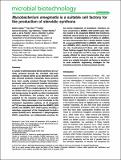Por favor, use este identificador para citar o enlazar a este item:
http://hdl.handle.net/10261/147640COMPARTIR / EXPORTAR:
 SHARE SHARE
 CORE
BASE CORE
BASE
|
|
| Visualizar otros formatos: MARC | Dublin Core | RDF | ORE | MODS | METS | DIDL | DATACITE | |

| Título: | Mycobacterium smegmatis is a suitable cell factory for the production of steroidic synthons |
Autor: | Galán, Beatriz CSIC ORCID ; Uhía, I. CSIC; García-Fernández, Esther CSIC; Martínez, Igor CSIC ORCID; Bahíllo, Esther; de la Fuente, Juan L.; Barredo, José L.; Fernández-Cabezón, Lorena CSIC ORCID; García, José Luis CSIC ORCID | Fecha de publicación: | 2017 | Editor: | John Wiley & Sons | Citación: | Microbial Biotechnology 10:138-150 (2017) | Resumen: | A number of pharmaceutical steroid synthons are currently produced through the microbial side-chain cleavage of natural sterols as an alternative to multistep chemical synthesis. Industrially, these synthons have been usually produced through fermentative processes using environmental isolated microorganisms or their conventional mutants. Mycobacterium smegmatis mc2155 is a model organism for tuberculosis studies which uses cholesterol as the sole carbon and energy source for growth, as other mycobacterial strains. Nevertheless, this property has not been exploited for the industrial production of steroidic synthons. Taking advantage of our knowledge on the cholesterol degradation pathway of M. smegmatis mc2155 we have demonstrated that the MSMEG_6039 (kshB1) and MSMEG_5941 (kstD1) genes encoding a reductase component of the 3-ketosteroid 9a-hydroxylase (KshAB) and a ketosteroid D1-dehydrogenase (KstD), respectively, are indispensable enzymes for the central metabolism of cholesterol. Therefore, wehave constructed a MSMEG_6039 (kshB1) gene deletion mutant of M. smegmatis MS6039 that transforms efficiently natural sterols (e.g. cholesterol and phytosterols) into 1,4-androstadiene-3,17-dione. In addition,we have demonstrated that a double deletion mutant M. smegmatis MS6039-5941 [DMSMEG_6039 (DkshB1)and DMSMEG_5941 (DkstD1)] transforms natural sterols into 4-androstene-3,17-dione with high yields.These findings suggest that the catabolism of cholesterol in M. smegmatis mc2155 is easy to handle and equally efficient for sterol transformation than other industrial strains, paving the way for valuating this strain as a suitable industrial cell factory to develop à la carte metabolic engineering strategies for the industrial production of pharmaceutical steroids. | Descripción: | 13 p.-3 fig.-3 tab. | Versión del editor: | http://dx.doi.org/10.1111/1751-7915.12429 | URI: | http://hdl.handle.net/10261/147640 | DOI: | 10.1111/1751-7915.12429 | E-ISSN: | 1751-7915 |
| Aparece en las colecciones: | (CIB) Artículos |
Ficheros en este ítem:
| Fichero | Descripción | Tamaño | Formato | |
|---|---|---|---|---|
| Gal-n_et_al-2017-Microbial_Biotechnology.pdf | 278,35 kB | Adobe PDF |  Visualizar/Abrir |
CORE Recommender
PubMed Central
Citations
18
checked on 14-abr-2024
SCOPUSTM
Citations
42
checked on 23-abr-2024
WEB OF SCIENCETM
Citations
32
checked on 26-feb-2024
Page view(s)
333
checked on 23-abr-2024
Download(s)
244
checked on 23-abr-2024

